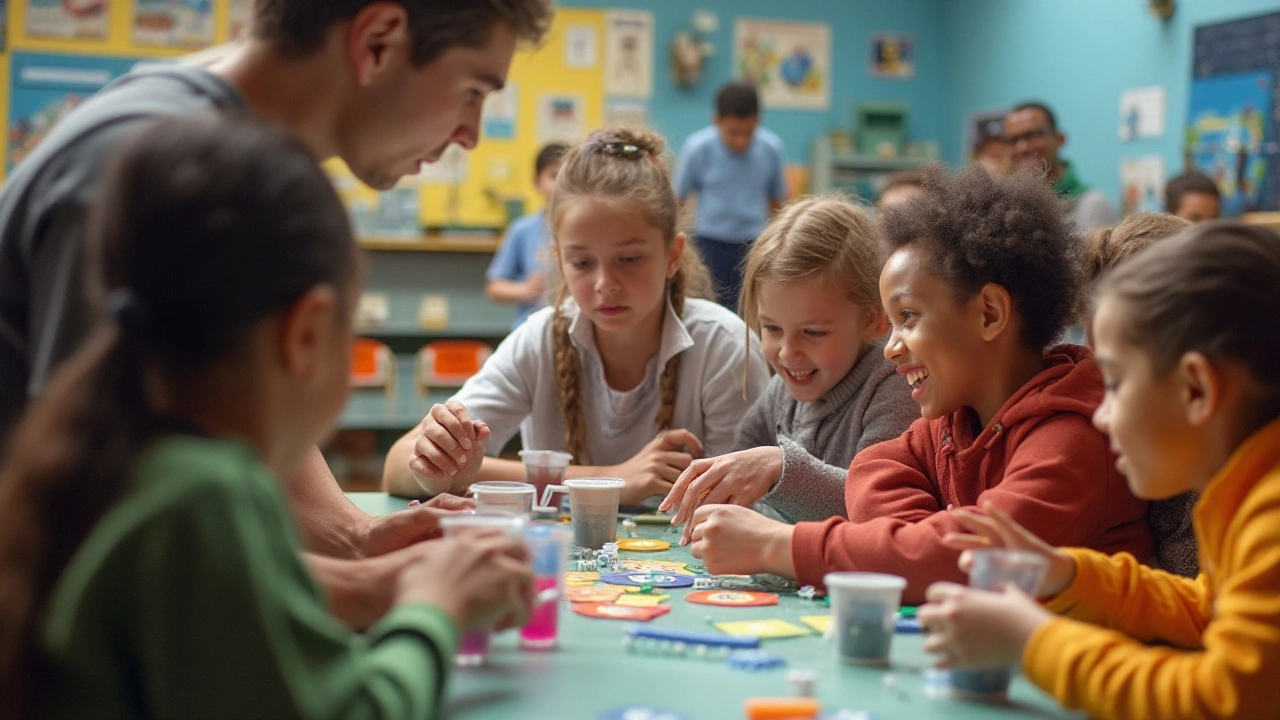Imagine a kids club that bursts with laughter, colors, and the spirit of discovery. Achieving such an environment requires more than just a collection of games and snacks. It's about creating a space where young minds feel inspired and eager to explore.
By focusing on what truly interests children, integrating creative activities, and ensuring the setting is inviting, you can turn any after-school club into a lively adventure. With the right mix of educational tools and fun, you can nurture a space that doesn't just entertain but also enriches.
- Understanding Children's Interests
- Creative Activities and Games
- Creating a Welcoming Atmosphere
- Using Educational Tools Effectively
Understanding Children's Interests
To truly engage children in any after-school club, it's vital to first delve into their individual passions and curiosities. Children are like sponges at this stage, absorbing information and experiences with an unbounded enthusiasm for life. Engaging them requires a subtle balance between introducing new concepts and nurturing their existing interests. For instance, a child fascinated by the stars may thrive in a club that offers basic astronomy insights and nightly sky-watching opportunities. Identifying such specific interests can guide the direction of activities that resonate deeply with young participants.
Children's interests are often an extension of their daily life experiences and available stimuli. Access to diverse experiences, whether it's through books, peers, or cultural exposure, can significantly shape what they're drawn to. This means that one kid might develop an affinity for stories, illustrating a keen interest in joining a club where storytelling or drama is the norm. Providing a variety of experiences within the club environment can expose children to fields they may not have previously considered, broadening their horizons and encouraging multi-dimensional growth.
Research underscores the importance of engaging children in activities that align with their preferences. A 2019 study published in the Journal of Applied Developmental Psychology found that children engaged in self-chosen activities tend to show higher levels of persistence and satisfaction, leading to an overarching sense of well-being. When you align a club’s activities with the children's natural dispositions, their level of engagement can skyrocket, unraveling a world of possibilities
"The most effective form of education is that a child should play amongst lovely things." - Plato
To best understand these interests, actively listen to the kids, consider their feedback, and involve them in the decision-making process. Letting them co-create some aspects of their club activities makes them feel valued and respected, transforming a passive attendance into active participation. Children love when their opinions matter, and this inclusive approach not only boosts their confidence but fosters an environment where they feel they truly belong. By integrating children's insights into the planning stage, you effortlessly shift from offering generic entertainment to providing deeply personal and impactful experiences.
Implementing a feedback loop is another inventive method of staying attuned to their evolving interests. By regularly seeking their opinions on past activities and their suggestions for future events, you can keep the content refreshing and exciting. Encourage an ongoing conversation about what they currently find exciting or what new areas they'd like to explore. This, paired with an educator or facilitator who stays informed about current trends, such as popular games or subjects in youth culture, ensures the club maintains relevance and vibrancy in the eyes of its young members.

Creative Activities and Games
Designing engaging after-school fun involves more than handing out a set of crayons and paper. It requires intention, attention to detail, and a spark of creativity. Kids are naturally curious and energetic, eager to dive into activities that challenge their imagination and intellect. For example, organizing a themed art corner where children can explore different cultures through crafts not only entertains but also educates. Imagine a club that celebrates world heritage months; one week children might find themselves crafting colorful Mexican papel picado, learning about the nuances of this traditional art form. The next week, they could be creating intricate designs using Indian rangoli, gaining insight into another vibrant culture. Such activities tap into the universal love for creation, fostering a deep appreciation for diversity.
Let's consider games, too. Games that challenge mental prowess or enhance physical skills can form the backbone of a captivating kids club. Classic games like scavenger hunts never lose their charm. But how about adding a twist? Incorporate clues that involve solving simple math problems or riddles, making each victory a testament to their growing knowledge. Or consider the rise of escape room experiences tailored for kids, where teamwork and problem-solving pave the way out of sticky situations. A report by the American Journal of Play found that such activities significantly enhance cognitive flexibility and social skills, attributes crucial for childhood development. By framing activities in a way that aligns with children's innate interests and abilities, you turn learning into an exciting journey.
Nurturing creativity also means leaving room for free expression through storytelling. Perhaps introduce a story circle where each child contributes to a chapter of a grand adventure. Academic studies have shown that story creation boosts literacy and cognitive development, offering children a priceless amalgam of language skills and creativity enhancement. As children's author Neil Gaiman once said,
"Stories you read when you're the right age never quite leave you. You may forget who wrote them or what the story was called. Sometimes you'll forget precisely what happened, but if a story touches you it will stay with you, haunting the places in your mind that you rarely ever visit."Encouraging kids to share their budding tales during meetings could transform your club into a haven of imagination.
For those who prefer the rush of fingers on keyboard keys, coding activities prove invaluable. Today, coding isn't just a skill confined to textbooks; it is an art form of logic and inventiveness. Programs like Scratch enable children to create their own interactive stories and animations, blending play with education seamlessly. Data from the National Education Technology Plan highlights how coding clubs improve digital literacy, foster collaborative learning, and often improve students' performance in problem-solving tasks. Integrating some tech time into your kids club ideas not only prepares them for the future but also ignites a passion for innovation.
Finally, considering the sensory aspect of activities is paramount. Sensory play, such as constructing a miniature garden with varied textures and scents, plays a vital role in children's sensory development. Engaging after-school activities could include DIY projects where children create their own aromatic play dough by mixing flour, water, and a few drops of essential oils. This kind of play is not only therapeutic but allows children to dive hands-on into the exploration of the world around them. Researchers from the Child Development Institute confirm that sensory play supports language development, cognitive growth, motor skills, and social interaction, which are foundational to childhood development.

Creating a Welcoming Atmosphere
Entering a space that feels inviting can significantly impact a child's experience in a kids club. The atmosphere should resonate warmth and excitement, sparking curiosity the moment they step in. First impressions matter and setting up a visually captivating entrance, perhaps with playful murals or displays of children’s art, can help create an initial connection. The colors used in the club can also affect mood; bright, cheerful tones tend to evoke positive, energetic feelings, essential for cultivating an engaging environment. Research from color psychology suggests that colors like blue enhance productivity and yellow promotes happiness, which can be strategically incorporated into the setting. Allowing natural light to fill the room whenever possible will also enhance the ambience.
Besides visual appeal, it’s crucial that kids feel safe and comfortable in the physical space. Arrange furniture to create cozy nooks where they can relax and engage in quieter activities if needed. Bean bags or soft rugs can work wonders, offering a sense of comfort and coziness. Organizing materials and activities at eye level adds a sense of accessibility, empowering children to choose and explore areas that interest them freely. A welcoming atmosphere goes beyond physicality; it also includes creating a culture of inclusivity and respect, where every child feels accepted and valued. This can be fostered by establishing group norms at the onset, encouraging kind interactions, and modeling respect through adult behaviors.
To deepen connections, build a sense of community within the club. Encourage kids to interact by incorporating team-building activities that require collaboration and communication. These not only improve social skills but also strengthen bonds among participants, creating an emotional attachment to the club. Including a designated space for showcasing children’s work can be a strong motivator, fueling a sense of pride and belonging. Lucille Clifton once said,
“What they call you is one thing. What you answer to is something else.”This reminds us of the power of identity and the role these clubs play in shaping a child's self-view.
Engaging the five senses is another effective way to cultivate a vibrant ambiance. Think about incorporating elements that stimulate each sense, like a calm music playlist that sets a soothing background, scents such as lavender or citrus that can invigorate or calm, and tactile experiences with sensory bins filled with different textures. Taste can be involved through healthy snacks or cooking activities, expanding the experience beyond the traditional. Welcoming atmospheres are dynamic and should evolve with the children’s interests and needs. By regularly seeking feedback from the participants, the club can continuously innovate and improve, ensuring it remains an exciting environment for all involved.

Using Educational Tools Effectively
Creating a fun and engaging kids club can be significantly enhanced by wisely incorporating educational tools that bridge play with learning. These tools are more than just aids; they're gateways that open new worlds for children’s developing minds. It's essential to choose equipment that kindles curiosity and supports diverse learning styles. Educational tools like interactive boards and tablets with age-appropriate software can offer dynamic learning experiences. They aren't just electronic babysitters but powerful platforms for children to create their own adventures, solve puzzles, and even design simple codes. It's about making technology a bridge to explore rather than a barrier.
Including physical tools like manipulatives, blocks, and science kits can encourage hands-on experimentation. These resources are invaluable for tactile learners who understand by doing. Providing diverse materials that cater to different types of learning can help keep every child engaged. A well-curated library within the club can introduce stories from various cultures, promoting inclusivity and empathy. Books with vivid illustrations captivate young imaginations, making storytime a voyage to new worlds.
When utilizing digital platforms, comprehensive children’s education playlists on platforms like YouTube or learning apps can be indispensable. It is crucial, however, to moderate screen time with energetic activities. Allow kids to balance exploration in digital realms with physical play. As technology evolves, virtual or augmented reality experiences are slowly becoming more accessible. These tools can offer immersive experiences such as visiting the deep ocean or ancient civilizations, turning abstract concepts into tangible experiences.
"Education is not the filling of a pail, but the lighting of a fire." — William Butler Yeats
An excellent method for utilizing tools effectively is keeping feedback loops open. Assess what works well through surveys or feedback sessions with the kids. Are they curious? Ask them which tools spark excitement and which ones could use a boost. Adapting to their interests ensures that the tools remain not just relevant but exciting. The opportunity here is to create a space where learning feels organic and exciting, a natural extension of play.
Integrating STEM Tools
For older kids in the club, incorporating STEM tools like robots or simple circuitry kits can challenge their understanding of science and math in a playful setting. Organizing mini-projects or competitions encourages teamwork and leadership skills. When children collaborate to build a structure or solve a problem, they learn more than just technical skills. They're learning critical social and emotional aptitudes as well. Club leaders can guide these projects by asking open-ended questions, stimulating critical thinking. Encourage kids to hypothesize, experiment, and explore the 'why' and 'how' of things.
Let them stumble and puzzle, providing tools, but not all the answers. Encouraging self-led discovery can lead children to unexpected places and ensure that learning is as much about the process as the outcome. Creating this atmosphere of exploration can propel a kids' club into a dynamic learning environment where children feel motivated and inspired. The ultimate goal is to make kids feel that learning isn’t confined to schools or textbooks. It's a joyous adventure that extends into the endless possibilities of their daily lives and the world around them.
